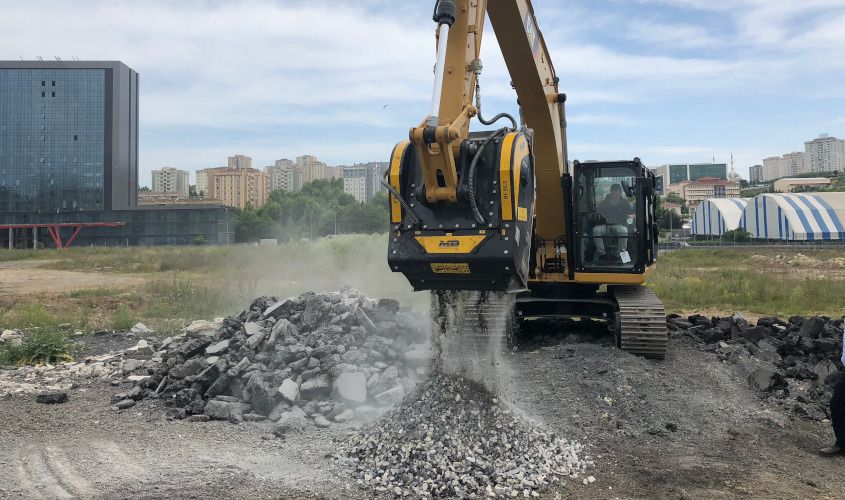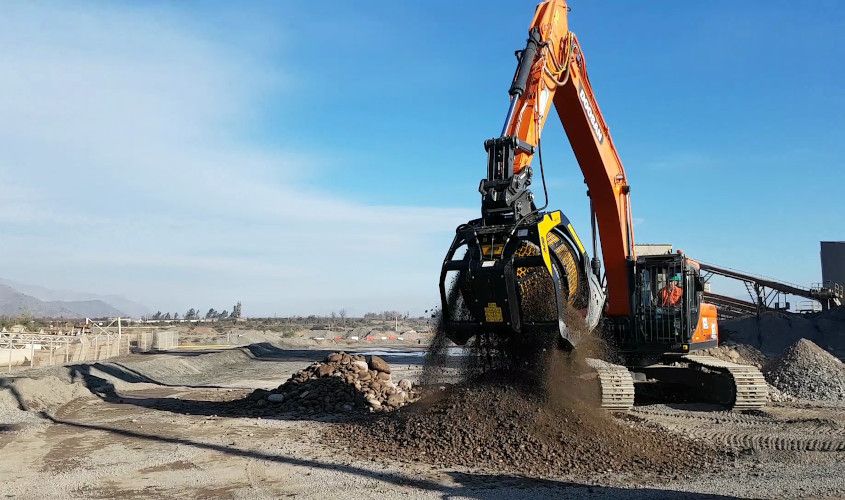
The BF90.3 crusher bucket is crushing black basalt in Turkey on a Caterpillar 320 GC excavator.
Thanks to MB, filling previously excavated areas, creating road foundation, drainage systems, and new construction can be made with the same materials present on site.

The BF135.8 crusher bucket working on a construction site in Norway to help construct a hospital.

The MB-S18 screening bucket is screening pebbles and basalt in Chile.
Thanks to MB, filling previously excavated areas, creating road foundation, drainage systems, and new construction can be made with the same materials present on site.
Basalt
Basalt is a popular natural stone. Due to its physical-mechanical properties it is used in a variety of ways and purposes. The word basalt derives from the Latin word, “basanites,” which means “very hard rock”. Since ancient times, the material has been used in construction, both as road pavement and as fill for other projects.
With MB’s crushing and screening buckets and drum cutters, the hard stone can be processed inside the quarry, obtaining a uniform output size which is perfect for immediate use. In fact, the product can be used as:
- railway ballast
- aggregates for construction projects
- stable road substrates
RAILWAY BALLAST
The crushed stone under the tracks is used to cushion the vibrations caused by trains passing by and to avoid rainwater building up under the tracks. Basalt is used because it has good resistance to mechanical stress and impact. The material can be produced by reducing the size of the rocks using MB’s crusher bucket. When selecting and separating the fine and large rocks, the process can be done quickly and easily with the screening bucket: the fines come out of the basket while the larger rocks remain in the bucket.
Crushing and screening can also be applied when recovering the ballasts. The crushed stone is dirty, and needs to be replaced. Once it’s removed and cleaned up and once it’s processed by one of MB Crusher’s units, the material can be reused as backfill or as road substrate.
AGGREGATES IN CONSTRUCTION PROJECTS
Aside from ballast, it can also produce aggregates according to your desired output size. Because of this, the combination of the crusher and the screening bucket is the winning solution when obtaining quality material. The crusher’s jaws can be adjusted to acquire a variety of output sizes for different uses, while the screening panels can be changed directly on site.
STABLE ROAD SUBSTRATES
With MB Crusher units, basalt can be recycled and used as a stabilizer, regardless of the construction site’s location. By installing the units to the excavators already present on site, the attachments can produce ready-to-use material. This eliminates any need for transportation and disposal services.
Crusher Buckets
- ≥ 6,5 ≤ 10 Ton
- ≥ 8 ≤ 9 Ton
- ≥ 6,5 ≤ 10 Ton
- ≥ 8 ≤ 9 Ton
Drum cutters
- ≥ 3,5 ≤ 11 Ton
- ≥ 3,5 ≤ 6 Ton
- ≥ 3,5 ≤ 11 Ton
- ≥ 3,5 ≤ 6 Ton
















